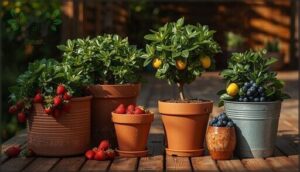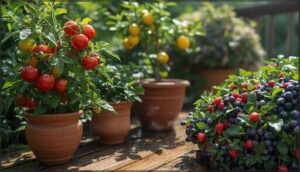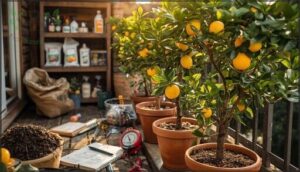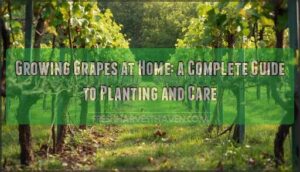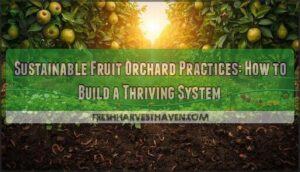This site is supported by our readers. We may earn a commission, at no cost to you, if you purchase through links.

Day-neutral strawberries, compact blueberries, and dwarf citrus varieties like Meyer lemons thrive in containers when you use quality soilless potting mix and maintain consistent watering schedules.
Vertical planters and tiered systems help you squeeze maximum yields from minimal square footage. The secret lies in matching container size to plant needs and understanding which varieties actually flourish in confined spaces.
Table Of Contents
- Key Takeaways
- Choosing The Best Containers for Fruit
- Top Fruit Varieties for Containers
- Soil, Water, and Sunlight Requirements
- Space-Saving Solutions for Small Gardens
- Maintenance Tips for Productive Fruit Gardens
- Maximizing Success in Container Fruit Gardening
- Frequently Asked Questions (FAQs)
- Can fruits be grown in containers?
- Can berries grow in containers?
- How do you grow fruit plants in a container?
- What are the best fruit trees for containers?
- How do I choose a fruit container?
- What are the Best Container gardening ideas?
- What fruits grow best in containers?
- What is the most common mistake made with container plants?
- What is the ideal size of container for fruiting vegetables?
- Which fruit trees are best for pots?
- Conclusion
Key Takeaways
- You’ll maximize success by choosing containers of at least 40-50 liters for dwarf fruit trees and ensuring proper drainage holes to prevent waterlogged soil that kills plants.
- You can grow abundant fruit in small spaces using dwarf varieties like Meyer lemons, compact blueberries, and day-neutral strawberries that produce multiple harvests yearly.
- You’ll need a quality soilless potting mix with proper pH levels (4.5-5.5 for blueberries, 6.0-7.0 for citrus) and consistent daily watering since containers dry out faster than ground soil.
- You can triple your growing space using vertical planters, tiered systems, and hanging baskets that stack fruit production upward instead of outward.
Choosing The Best Containers for Fruit
Selecting the right container sets the foundation for a thriving fruit garden, whether you’re growing strawberries on your balcony or dwarf citrus trees on your patio.
The container’s size, material, and drainage capabilities directly impact your plants’ health and productivity. Understanding these factors helps you make informed choices that lead to bountiful harvests.
Ideal Container Sizes for Fruit Crops
Container sizes directly impact your fruit yield and plant health. Dwarf fruit trees need 40-50 liters for proper root space, while blueberries thrive in 35+ liter containers. Small containers limit crop capacity – strawberries flourish in 3-5 liter pots individually, but larger planters boost productivity.
Container depth matters too: citrus trees require 45-55 cm deep pots for stability and soil volume retention. When selecting containers, consider the importance of proper fruit storage to maintain fruit quality.
Material Options—Plastic, Wood, Ceramic
Your choice of container material shapes both your plants’ health and your gardening experience. Wooden planters offer natural insulation and breathability, while plastic containers provide lightweight portability and moisture retention. Ceramic pots and terra cotta deliver excellent aeration through porous walls, though they’re heavier.
Consider recycled materials for sustainable options that reduce environmental impact while creating thriving container gardens.
When selecting ceramic containers, understanding ceramic planter characteristics is vital for ideal plant growth.
Importance of Drainage and Aeration
Without proper drainage systems and soil aeration, your container gardens become waterlogged graveyards where root health deteriorates rapidly. Effective water management prevents moisture from stagnating, ensuring your fruit plants don’t drown in their own containers. You’ll need drainage holes in every pot, plus breathable pots like terra cotta that maintain oxygen levels around roots.
Weatherproofing and Mobility Tips
Smart mobility transforms your portable gardens into weather-resistant growing systems. Install plant stands with rollers for seamless seasonal movement, protecting delicate fruits from harsh winds and temperature swings.
Choose breathable pots with adequate drainage holes, ensuring your container gardening thrives year-round. This patio gardening approach optimizes small space gardening success through strategic weather protection.
Effective fruit tree care techniques also involve regular pruning and fertilization to promote healthy growth.
Top Fruit Varieties for Containers
You’ll discover that certain fruit varieties thrive in containers, producing impressive harvests even in limited space. The best container fruits combine compact growth habits with high productivity, giving you fresh fruit without requiring a traditional garden.
Strawberries and Blueberries
Strawberries (Fragaria x ananassa) and blueberries (Vaccinium) offer outstanding fruit nutrition while thriving in containers. You’ll need 18-inch wide strawberry pots for berries and 24-inch containers for blueberries. Day-neutral strawberry varieties provide multiple harvests, while compact blueberry cultivars like Patriot resist berry pests.
Proper pollination methods boost yields, and quality soil with correct pH ensures prime harvest timing for your container gardening success. To achieve prime growth, understanding soil pH levels is vital for containerized blueberry plants.
Dwarf Figs and Peaches
Dwarf figs like ‘Little Miss Figgy’ (Ficus carica) deliver two harvests yearly in compact containers. These Dwarf Fruit Varieties need minimal Container Pruning compared to full-sized trees. Peach Variety ‘Pix Zee’ (Prunus persica) produces full-sized fruits in large pots, making Container Gardening incredibly rewarding. Both require consistent watering and full sun for ideal Fruit Harvesting success.
For proper growth, understanding soil types is essential for selecting the right fruit trees.
Citrus and Passion Fruit Options
Meyer lemon citrus trees thrive in containers, producing sweet-tangy fruits year-round. These dwarf fruit varieties need winterizing protection in cold climates—simply move them indoors.
Passiflora edulis requires hand pollination for fruit production, making it perfect for controlled container gardening.
Both tropical climate natives adapt well to growing fruits in containers, offering distinct flavor profiles that’ll transform your small-space harvest.
Compact Raspberries and Tomatoes
Compact varieties like ‘Raspberry Shortcake’ and determinate tomatoes thrive in containers without sacrificing yield. Rubus idaeus responds well to container gardening, while compact tomato varieties guarantee fruit pollination success. These container edibles optimize your growing space efficiently.
You’ll need tomato stakes for heavy fruiting branches and should practice raspberry pruning after summer harvesting.
Soil, Water, and Sunlight Requirements
Successfully growing fruit in containers requires matching your potting mix, watering routine, and sun exposure to each plant’s specific needs. You’ll achieve the best results when you understand how soil pH affects nutrient uptake and create consistent care schedules that prevent the common pitfalls of container gardening.
Selecting The Right Potting Mix
Your potting soil choice directly impacts your container edibles’ success. Skip regular garden soil—it’s too heavy and poorly draining for container gardens. Smart soil composition starts with quality ingredients that maintain proper moisture levels while supporting healthy root development.
- Soilless potting mix: Contains peat moss, vermiculite, and perlite for ideal drainage
- Organic matter blend: Adds compost or aged bark to boost nutrient retention
- Fertilizer-enhanced formula: Includes slow-release nutrients for sustained feeding
Managing Soil PH for Specific Fruits
Once you’ve chosen the right potting mix, soil testing becomes your gateway to fruit success. pH balancing transforms ordinary container gardening into a precision science that releases maximum yields.
| Fruit Type | Ideal pH Range |
|---|---|
| Blueberries | 4.5 – 5.5 |
| Strawberries | 5.5 – 6.5 |
| Citrus Trees | 6.0 – 7.0 |
| Raspberries | 6.0 – 6.8 |
| Dwarf Peaches | 6.0 – 6.5 |
Fruit specificity drives nutrient management success. Acidic conditions favor blueberries, while citrus thrives in neutral garden soil.
Regular monitoring prevents pH drift that stresses edible plant care systems. Fruit tree care requires monthly testing during the growing season for ideal garden soil preparation.
Daily Sunlight and Placement Strategies
Most fruits need full sun exposure for ideal production, but strategic container placement gives you flexibility. You’ll want six to eight hours of sunlight daily for maximum yields, with morning light particularly beneficial for fruit development.
- South-facing locations provide consistent direct sunlight throughout the day.
- Window placement indoors extends growing seasons for tender container edibles.
- Shading techniques protect patio pots during extreme afternoon heat.
- Hanging baskets can be repositioned easily to follow optimal light patterns.
Watering Schedules for Healthy Growth
Daily watering becomes your lifeline when containers dry out faster than ground soil. You’ll need consistent water schedules, especially during summer heat waves. Monitor moisture levels with your finger—stick it two inches deep into soil. Most fruiting plants require daily watering, but drainage prevents waterlogged roots that spell disaster for your harvest.
| Fruit Type | Water Frequency | Soil Monitoring Method |
|---|---|---|
| Strawberries | Daily (summer), Every 2-3 days (spring/fall) | Check top inch of soil |
| Citrus Trees | Every 2-3 days | Insert finger 2 inches deep |
| Blueberries | Daily during fruiting season | Maintain consistently moist soil |
| Dwarf Stone Fruits | Daily (hot weather), Every other day (mild) | Test moisture at root zone |
Consider drip irrigation systems for hands-free watering that delivers moisture directly to roots. Container gardening demands attention to humidity control—group plants together to create beneficial microclimates. Always water slowly with gentle fertilizer mixed in monthly, allowing proper drainage to prevent root rot.
Space-Saving Solutions for Small Gardens
When you’re working with limited garden space, choosing dwarf and compact fruit varieties transforms tiny areas into productive growing zones.
You can increase your harvest by using vertical planters, trellis systems, and tiered hanging containers that stack your fruit production upward instead of outward.
Dwarf and Compact Fruit Varieties
When you’re working with limited space, dwarf and compact fruit varieties become your best allies for maximizing harvests. These miniature plants pack full-sized flavor into containers, making fruit tree selection straightforward.
Dwarf varieties like ‘Pix Zee’ peaches and ‘Little Miss Figgy’ reach only 4-6 feet tall, while compact trees fit perfectly in large pots without sacrificing productivity.
Vertical Planters and Trellis Systems
Vertical gardens transform small spaces into productive fruit-growing powerhouses using wall-mounted systems and aerial planters. These space savers increase your container growing potential while keeping container fruits accessible.
- Trellis designs support climbing varieties like passion fruit and grapes in containers
- Vertical gardens increase yields up to 20 times per square foot compared to ground planting
- Wall-mounted systems improve air circulation, reducing disease rates by 40%
- Container edibles grown vertically receive better sunlight exposure for improved flavor
By using vertical growing methods, gardeners can refine their space and increase productivity.
Using Tiered and Hanging Containers
With tiered planters and hanging baskets, you’ll utilize every inch of your growing space. Stack containers vertically to create multi-level vertical gardens that transform small patios into productive spaces.
Hanging baskets work perfectly for trailing strawberries, while container stacking lets you grow different fruits at various heights.
This space optimization approach doubles your container growing potential without expanding your footprint—perfect for cramped patio pots.
Maintenance Tips for Productive Fruit Gardens
Once you’ve established your container garden, proper maintenance becomes the key to abundant harvests year after year. Regular fertilization, strategic pruning, and proactive disease prevention will keep your fruit plants thriving in their limited space.
Fertilization and Soil Renewal
Regularly feeding your container fruits reveals their full potential through strategic nutrition management. Your plants need consistent nourishment since container environments quickly deplete nutrients through drainage and root absorption.
- Organic fertilizers like Alaska Fish Fertilizer provide slow-release nutrition while compost tea delivers beneficial microorganisms for healthy soil biology
- Soil pH management guarantees favorable nutrient uptake—test monthly and adjust with organic amendments to maintain proper growing conditions
- Vermicasting and nutrient cycling through regular potting soil renewal prevent salt buildup while maintaining fertile growing medium for sustained production
Pruning, Training, and Pest Management
Annual tree pruning keeps your dwarf fruit trees healthy by removing dead branches and opening canopies for better airflow. Root pruning every 2-3 years prevents binding and boosts yields. Train branches using stakes and ties while they’re young. Monitor weekly for pests like aphids and spider mites, treating early with neem oil or beneficial insects.
| Pruning Techniques | Training Methods | Pest Control Methods |
|---|---|---|
| Remove dead branches annually | Stake young branches early | Weekly pest inspections |
| Clear interior shoots for airflow | Use espalier for space-saving | Apply neem oil at first signs |
| Root prune every 2-3 years | Maintain open center structure | Release beneficial insects |
| Prune during dormant season | Redirect 30% of annual growth | Use dormant oil before buds |
Rotating Crops and Disease Prevention
Smart gardeners know that crop rotation and disease prevention go hand-in-hand for thriving container gardens. You’ll prevent soil-borne pathogens by switching fruit types between containers annually and sanitizing pots with bleach solution. This rotating crops strategy breaks pest cycles while maintaining soil health through proper fertilizer management and fresh potting mix.
Effective garden disease prevention tips, such as soil health management, are essential for maintaining a productive fruit garden.
Harvesting and Storing Container Fruits
Perfect fruit ripening timing separates amateur gardeners from seasoned pros in container fruit gardening. You’ll increase crop yield by checking fruits daily for color changes and gentle give. Store berries refrigerated for extended freshness, while stone fruits ripen best at room temperature.
Master these preservation techniques to extend your fruit production season. Container gardening rewards patience—harvest when nature signals readiness, not your schedule demands freedom.
Maximizing Success in Container Fruit Gardening
Container fruit gardening offers outstanding flexibility and control over growing conditions, letting you increase harvests even in the smallest spaces. You’ll overcome common challenges like poor soil, limited space, and weather extremes while enjoying fresh fruit right outside your door.
Benefits of Container Gardening
Container gardening breaks you free from soil limitations while maximizing your growing potential. You’ll discover unique flexibility options that transform any space into a productive harvest zone.
- Season Extension: Move containers indoors during harsh weather, extending your growing season by months.
- Soil Control: Create perfect growing conditions for each fruit variety without amending yard soil.
- Space Efficiency: Grow multiple container fruit seed plants in compact areas where traditional gardens won’t fit.
Choosing dwarf fruit trees makes container gardening even more manageable.
Overcoming Common Challenges
While container gardening offers flexibility, you’ll face specific challenges that can make or break your harvest. Root bound conditions develop when plants outgrow their containers, restricting nutrient uptake and requiring repotting every 2-3 years. Nutrient deficiency occurs faster than ground plantings due to frequent watering that leaches minerals.
Combat garden pest control issues through consistent water schedules and proper drainage to prevent stressed plants that attract insects.
Climate adaptation becomes easier since you can move containers during temperature extremes, protecting your investment from soil erosion and moisture fluctuations.
Frequently Asked Questions (FAQs)
Can fruits be grown in containers?
Yes, you’ll discover nature’s bounty right on your patio! Fruits thrive in containers when you provide proper drainage, adequate pot size, and consistent care for rewarding harvests.
Can berries grow in containers?
Berries thrive in containers when you provide proper drainage and adequate space. Strawberries, blueberries, and compact raspberry varieties like ‘Raspberry Shortcake’ produce excellent harvests in pots with consistent watering and acidic soil conditions.
How do you grow fruit plants in a container?
Turn your growing space into a fruit paradise by choosing large containers with excellent drainage. You’ll need full sun, proper soil mix, consistent watering, and regular fertilization to nurture thriving fruit plants successfully.
What are the best fruit trees for containers?
Dwarf citrus trees like ‘Meyer Lemon’ and compact fruit varieties such as ‘Little Miss Figgy’ dwarf figs thrive in large containers, delivering fresh harvests without requiring yard space.
How do I choose a fruit container?
What container features matter most for healthy fruit production? Choose containers at least 12 inches deep with drainage holes, use breathable materials like terra cotta, and guarantee adequate size for your fruit variety’s root system.
What are the Best Container gardening ideas?
You’ll increase your harvest by growing compact varieties like dwarf citrus, strawberries, and dwarf figs in large containers with excellent drainage.
Choose breathable pots, use quality soil-less media, and position them for ideal sunlight exposure.
What fruits grow best in containers?
Strawberries, dwarf figs, blueberries, and citrus trees like Meyer lemons thrive in containers. You’ll get excellent results with compact varieties such as ‘Little Miss Figgy’ figs and ‘Raspberry Shortcake’ raspberries that produce abundant harvests.
What is the most common mistake made with container plants?
Here’s your death trap: overwatering. You’re drowning your plants with kindness, creating soggy soil that suffocates roots and invites root rot, eventually killing what you’re trying to nurture.
What is the ideal size of container for fruiting vegetables?
You’ll need large pots with at least 12 inches in diameter and depth for fruiting vegetables. This size gives roots room to develop properly and promotes healthy fruit production throughout the growing season.
Which fruit trees are best for pots?
Dwarf citrus trees like ‘Meyer Lemon’, compact figs such as ‘Little Miss Figgy’, and dwarf peach varieties like ‘Pix Zee’ thrive in containers, producing quality fruit in manageable sizes.
Conclusion
Successfully starting your container fruit gardening journey transforms tiny spaces into thriving, productive paradises. You’ve discovered that proper container selection, suitable soil preparation, and strategic plant placement create ideal growing conditions.
Your container fruit gardening ideas will flourish when you maintain consistent watering schedules, provide adequate sunlight, and choose dwarf varieties perfectly suited for confined spaces.
With dedication and proper planning, you’ll harvest fresh, homegrown fruits year-round from your compact garden sanctuary.
- http://yougrowgirl.com/growing-an-edible-strawberry-pot/
- http://shewearsmanyhats.com/easy-blueberry-pie-recipe/
- http://preparednessmama.com/grow-blueberries-in-pots/
- http://www.madaboutberries.com/raspberries/growing-everbearing-raspberries-in-containers.html
- https://balconygardenweb.com/best-fruits-to-grow-in-pots-fruits-for-containers/

